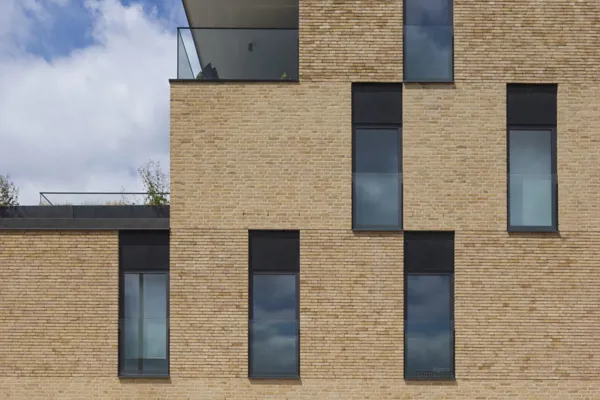Facing bricksBrick M
Technische informatie
- Kleur omschrijving
- The colour of the body is yellow ochre.
- Afmeting (L x B x H)
- ca. 225x74x54 mm (LxBxH)
- Aantal / m² met een traditionele voeg
- 64 (12 mm)
- Aantal / m² met een dunne voeg
- 73 (6 mm)
Brick M
Yellow ochre ecological Waal format
Brick M is a yellow ochre (Premium ochre pure) moulded brick produced using the Wasserstrich method. It carries both our Hand-Made label and the ECO-7-size label. Our Hand-Made label guarantees a strong, natural nuance. The unsanded Brick M also carries the ECO-7-size label because it is 7 cm deep, unlike the classic Waal format which is 10 cm deep. Minerals are added during the production process to give this facing brick a unique surface texture.
reportage Brick M

Ochre-tinted Brick M enhances contrast between different processing methods
Striking, timess and innovative brick architecture
It was not by chance that ‘Residentie Corda’ comprising 15 apartments and one office space was given its name. ‘Corda’ is a German motorcycle manufacturer specialising in sidecar combinations, asymmetric constructions just like the architecture of the building.

The ecological facing brick ‘Nature7 Brick M’ accentuates the urban character of Leiekouter Ghent with a nod to the past
360 Architecten restores the atmosphere of a residential neighbourhood to the riverbank
Complex inner-city projects are challenging but extremely exciting at the same time. Leiekouter in Ghent is a fine example of this type of project.
Lees verder
Referenties
Verwerkingstips
Preparation of the construction site
- Always order the full amount of bricks required for a specific site. In this way, the entire order can be made during one production run.
- Try to have the full order supplied at one time. If this creates several deliveries, always mix a number of packs from the previous delivery with a number of packs from the new delivery. This procedure is especially recommended in case of re-order or for an additional order.
- Take bricks diagonally across the pack.
- Draw and use bricks from at least five different packs.
- For setting out, use bricks from the delivery made to the site in question. Do not exclusively use the theoretical dimensions of the brick, or samples previously supplied, or different production run from that intended for the site.
- As soon as the bricks arrive on site, check delivery tickets and certificates against the specification and order. Also check that there are no visible inconsistencies with the order.
- Do not lay bricks in freezing weather or protect the ‘fresh’ masonry with insulating mats in order to avoid frost damage to the mortar.
- In the case of prolonged dry hot weather, lightly dampen the newly laid brickwork to stop the mortar drying and curing too quickly.
- Do not lay bricks in precipitation in order to prevent mortar from running on the wall.
Avoid Efflorescence
- During and after laying, protect the newly built brickwork for a height of at least 60 cm - but ensure there is airspace between the brick face and the waterproof covering.
- Provisionally install rainwater down pipes to avoid saturation of the newly laid brickwork
- Never lay bricks in driving rain conditions






















